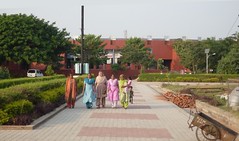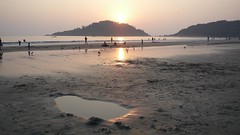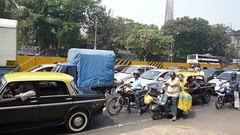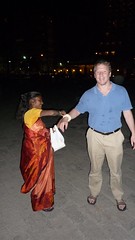India 10: Reflections on India
The most significant thing that strikes me about India is the colours. England and the West looks positively drab by comparison. Everywhere you look, bold bright colours can be seen. Women dress in striking coloured sarees to go about their daily business - even the poorest women still look beautifully dressed.
And it doesn't stop at the women. Buildings and office blocks are painted in bright reds, yellows and blues. Store fronts are decorated with fresh flower garlands each day. Even the vehicles are painted and adorned with flowers over their radiators. People decorate the entrances to their homes with intricate rangolis made from flower petals and pulses (and even more so at Diwali).And it's not just colours, you find all your senses overwhelmed - smells of spices and freshly cooked curries mixed with incense and earthy farmyard type smells as well the occasional smell of bad drains. And vehicle horns mingle with traders and taxi drivers hollering each other along with occasional religious chants and calls to prayer from loudspeakers above temples. Even the temples are varied, a fusion of Islam and Hindu styles. And the taste too - The curries we have at home are not a patch on real Indian food. There is no "curry powder" here. Each dish is delicately crafted with the precise mix of chillies herbs and spices to complement its ingredients.
The thing that will stay with me most though is memories of the people here. Not are they incredibly warm and welcoming, they are more peaceful than any I've ever seen before. I saw no crime in India. Outside of tourist hotspots I saw minimal begging. What beggars you do see tend to put on an act and do it in tourist areas to earn a living, because they can earn more money that way, sadly. People wave as you pass by and greet you in the street. Everyone here just seems happy. And I literally mean everyone. We are glum by comparison.
It started to dawn on me when I looked at the "slum" outside my hotel in Ahmedabad, and on closer inspection I realised that while these people had little money, they were getting on with their lives. They had very basic rooves above their heads, and electricity and water. They keep their streets between the tin huts clean, and their kids play happily outside. This was not a slum as I'd imagined it, from African famine appeals and Geography textbooks. These were proud people going about their business. Maybe the climate helps, but it just felt like there is a kind of positivity - everyone just gets on with life.I think it really hit me though when we were driving into Mumbai from the airport and waiting in traffic. I saw a young girl of eight or so by the roadside. She was naked but for a pair of red shorts and had a pail of water by her, from which she was filling a small jug. She was rinsing and squeezing her clothes and then wringing them out on the pavement. She finished one garment and hung it on the railings by the roadside, and started on the next. I didn't feel horrified, and I wasn't sure why - surely I should be appalled at such a scene? But thinking about it afterwards I realised - that girl is not starving or malnourished, she is not begging, she has not given up on life. She was completely at ease with what she was doing. It was just part of her routine. And I think this sums up what the Indian people are about. Whether it comes from the belief in Karma, I don't know, but it seems that in India, you make the best of what life gives you. People don't spend all their time obsessing about how to make a better life for themselves. Which isn't to say they have no ambition - just that they maintain a happy and balanced outlook.
It's a really noble thing in a way, and it really makes you think about how we live our lives in the West. In general, we spend our lives in pursuit of more wealth or better partners, or we worry about fear losing what we already have. We obsess over what-ifs and might-have-beens without ever stopping to just enjoy what life has given us. I know that is probably a great over-simplification but I hope you can see what I am getting at. There is something we can learn from India. It's no wonder they are an up and coming force in the world. It's a country that's going places and which by and large hasn't been sucked into Western capitalist and media ideals (yet - I did see a few disturbing adverts for "skin whitening moisturiser" on the TV, and Mumbai feels quite a lot like other Western cities). I hope that as India grows to join the bigger, more "developed" nations of the world, it retains its vibrancy and individuality.
Read more...











